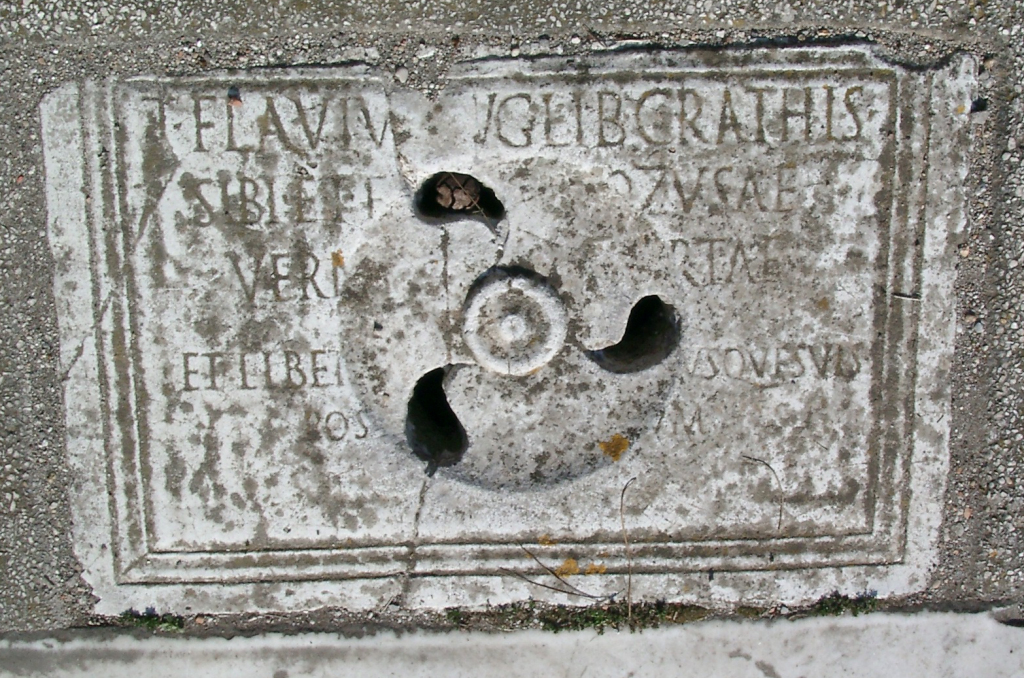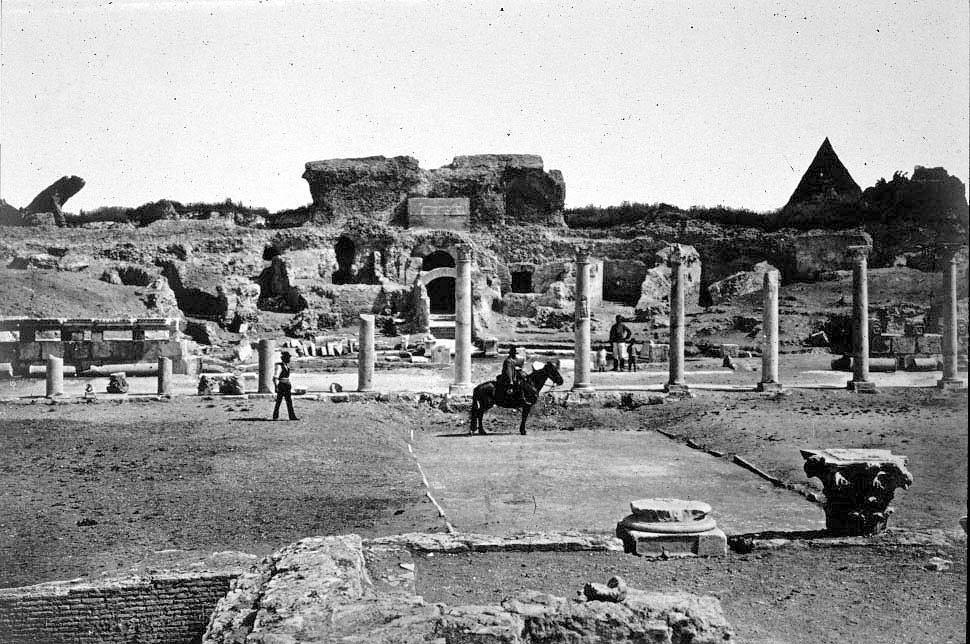A CITY WITH TWO FACES
Amidst collapsed and abandoned buildings, in the later third, fourth and early fifth century, there were also new initiatives. The last major temple that was built in Ostia is the Round Temple (I,XI,1), from the reign of either Alexander Severus (222-235 AD) or Gordianus III (238-244 AD). Aurelianus (270-275 AD) was responsible for a new forum near the sea. The Emperor Tacitus (275-276 AD) gave 100 marble columns to the city. In the third and fourth century many buildings were converted to domus, rich houses, perhaps used by merchants active in Portus. In the middle of the fourth century a monumental nymphaeum was erected on the Crossroads of the Castrum (I,XIV,1). The aqueduct functioned until the end of the fifth century. We also hear of restorations. At the end of the fourth century the cella of the Temple of Hercules (I,XV,5) and the Baths of the Forum (I,XII,6) were restored. Various Christian buildings have been found, notably a large church in region V.
On and around Via dei Balconi Guido Calza noted an almost complete absence of bricks in the layers, that is of the building material of the upper floors. He suggests that upper floors were torn down in late antiquity, for the collection of bricks. We now know that sometimes there was no need to tear down the walls: earthquakes had made them collapse. The bricks would have been reused in the south part of Ostia, where wealthy dwellings (domus) were installed, in Portus, or in Rome (as we shall see later on, building material was extracted as late as the 16th century). The marble used in the domus and the nymphaea had been taken from other buildings, also from the burial places. Of particular interest is the dispersion of the Fasti, the town records, that were kept until at least 175 AD. The fragments of the marble plaques that have been found so far had all been reused for the decoration of walls and floors. In the words of Raissa Calza, Guido Calza's wife, who was present during the 1938-1942 excavations: "The long marble slabs, shattered and dispersed later, were often used in the late period as thresholds for doors. After the first accidental discovery, we took care to remove the smooth marble slabs that served as thresholds of late houses at each new discovery to examine the reverse". All plaques seem to have been removed at the same time, and one place of discovery - the Building with Opus Sectile (III,VII,8) - suggests that this happened around 400 AD. Two major concentrations of fragments have been found: on and near the Forum of the Marine Gate (IV,VIII,1), so near the beach, and on and to the south-west of the central Forum. It is still not clear to which building they were originally attached.

A funerary inscription reused as drainage lid in the House of the Porch (V,II,4-5). Photo: Daniel González Acuña.
Somewhat curious is the history of an altar, dedicated to Hercules, that was reused in the mithraeum of the House of Diana. One corner was then missing, and the builders of the mithraeum filled the gap with masonry. In the years 1938-1942 the missing fragment was found on the Cardo, to the south of the Forum. Apparently the altar had been damaged in antiquity and the two parts had become separated. The missing fragment could, in antiquity, not be found. As we have seen above, the House of Diana seems to have been destroyed in the late third century, possibly by an earthquake. It is surprising that at such an early date damaged material was scattered over the city. Perhaps, therefore, the mithraeum was dug out later, after the destruction of the building. It would have become a perfect Mithraic cave.
In shops II,VIII,1 a wall was built to hide ruins from view for those walking on the Decumanus. An inscription on the Forum records the transfer of a statue "from sordid places" (ex sordentibus locis). Another inscription tells us that in the second quarter of the fourth century the Emperors Constantius and Constans restored long-neglected baths (thermas incuria longi temporis destitutas ... ad pristinum statum reformandas). At the end of the fourth century the theatre was restored, but statue bases with inscriptions from the Square of the Corporations were reused: the square was no longer used for commercial purposes. In the same period, on the shore, the walls of the Building with Opus Sectile were lavishly decorated with polychrome marble. For some reason the building collapsed, and it was left as it was. It did not help that the attention had shifted to Portus. Several laws from the fourth and early fifth century in the Codex Theodosianus pertain to Portus. They are about skippers, warehouses, grain measurers, and tow boats. But already in 364 AD the Emperors wrote to Symmachus, Prefect of the City: "We have learned that fiscal storehouses in the City of Rome and also in the Port have been converted to private uses".
At the end of the fifth century some building activity took place in the Basilica on the Pianabella, and in the years 493-526 some activity is documented in the Baths of the Marine Gate (IV,X,1-2), near the sea. A few walls in a building opposite the House of Annius (III,XVI,2) and in the House of the Fortuna Annonaria (V,II,8) have been dated to the sixth century. But these are sporadic activities. It was probably in this period that many people were buried in the city, in simple graves in buildings, such as the Barracks of the Fire Brigade (II,V,1-2), the block to the north of the barracks (II,XI), the Baths of Neptune (II,IV,2), the Antonine Warehouse (II,II,7), the Warehouse of Hortensius (V,XII,1), the Four Small Temples (II,VIII,2), the Baths of Mithras (I,XVII,2), and the Maritime Baths (III,VIII,2). One grave contained a bronze fibula of Germanic origin. To the south of the theatre a chapel of Cyriacus - the Christian Oratory (II,VII,1) - was built in the sixth century, at a very high level. A tomb near the chapel still exists, below a block of masonry. In the fifth or sixth century the arches of the first level of the theatre were blocked, so that the building could be used as a fortress.

The interior of the theatre in the late 19th or early 20th century.

The interior of the theatre as it appears today. Photo: Klaus Heese.